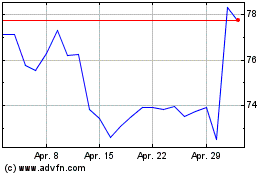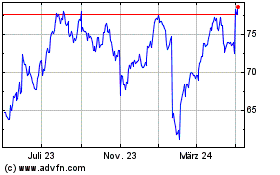By David Benoit
Dow Chemical Co. and DuPont Co. announced plans to merge Friday
in a transaction that combines two longtime rivals and heralds the
arrival of a new era of activist investing.
Dow and DuPont said they would combine into a chemical giant
worth more than $120 billion before splitting up into three
separate companies. While the plan was hatched by the companies'
chief executives, they worked alongside activist investor Nelson
Peltz, who played a central role in helping plan and execute the
deal, according to those involved.
As the merger plan came together in recent weeks, Mr. Peltz and
his colleague Ed Garden of Trian Fund Management LP worked behind
the scenes with Dow Chief Executive Andrew Liveris and DuPont's
Edward Breen.
That campaign kicked off when Messrs. Peltz and Garden were
invited in October to meet with DuPont's board in Baltimore. At the
meeting, the men encouraged the board to pursue a tie-up with
Dow--a move that, unbeknown to them, was recently under way.
The involvement of Trian is the latest sign of the growing clout
of activists. While they have become increasingly powerful in
recent years, forcing companies to do everything from buying back
stock to selling assets, their ability to help bring about such a
monumental deal represents a new high.
Once viewed as fighters from the fringe who would be kept far
from deal talks of two iconic companies, activist investors have
won acceptance from some executives and boards, who now sometimes
court their detailed analysis and thinking on decision making. That
has placed them at the center of some recent deals, such as the
ongoing role of William Ackman of Pershing Square Capital
Management LP in trying to merge railroads Canadian Pacific Railway
Ltd. and Norfolk Southern Corp.
Another activist, Daniel Loeb's Third Point LLC, also played a
role in the DowDuPont deal, albeit an indirect one. Mr. Loeb had
pressured Dow to break itself up last year and had criticized Mr.
Liveris, but had settled a pending proxy fight in exchange for two
directors. As part of that pact, Mr. Loeb was barred from public
comments on Dow for a year, but had privately kept his own pressure
on Dow's board and Mr. Liveris.
He wasn't involved in the deal talks and wasn't made aware
before The Wall Street Journal reported on the talks earlier this
week. But his standstill expires this weekend, meaning he could
have started a new fight soon, a possibility that was known during
the deliberations.
The following account is based on interviews with numerous
people close to the negotiations.
Mr. Liveris called Mr. Breen as soon as he was named interim CEO
at DuPont in October. Mr. Breen knew what the call was about before
he even picked up the phone, he said in an interview.
Messrs. Liveris and Breen, who had never met, agreed to get
together the following Sunday for brunch at a Philadelphia hotel.
They spent the afternoon discussing the benefits of bringing the
companies together and then breaking them into new entities. Mr.
Liveris pressed to move quickly, hinting that he had other
options.
Mr. Breen asked for a few days, and called back quickly, ready
to press forward on a deal.
The timing was right for both sides. Commodity prices continued
to sink and the U.S. dollar grew stronger, denting revenue for both
companies. Meanwhile, the companies' stock-market values were just
about the same, making a merger of equals easier to strike. Then,
Mr. Breen, a known deal maker, was given the reins with a mandate
to change the 213-year-old company.
Messrs. Breen and Liveris then met numerous times at various
hotels and sketched out the broad details of an agreement, handing
back and forth a roughly seven-page document. Advisers reminded
them that mergers-of-equals often founder when details aren't
agreed upon early.
A couple of weeks later, Messrs. Peltz and Garden were invited
to meet the entire DuPont board. It was the first meeting with the
whole board since they had begun a campaign for change at the
company more than two years earlier.
In the Four Seasons Hotel in Baltimore, the Trian duo sat at a
small table facing a large U-shaped table where the board of
Wilmington, Del.-based DuPont sat and listened. The directors said
little.
Trian didn't hold back, chastising the board for disappointing
results at the company and a spinoff they considered poorly
executed. The activists, representing DuPont's fifth-largest
shareholder with a roughly 3% stake, said they would support Mr.
Breen being named permanent CEO but wanted to see one of three
things happen: A breakup of DuPont; a deal between its agriculture
business and Syngenta AG; or a merger with Dow. They made clear the
deal with Midland, Mich.-based Dow was their preferred option.
Mr. Peltz had already learned from a lunch with Mr. Liveris in
late 2014 that Dow could be interested in a deal, and the two
discussed how one could be structured. Mr. Liveris, had long
desired the deal and previously worked out a plan with help from
his banker Michael Klein, founder of Klein & Co. But on this
day he demurred: The timing wasn't right.
At the Baltimore meeting, Mr. Breen gave no hint to the
investors he was already along the path toward a deal.
But after becoming permanent CEO in November, Mr. Breen arrived
at Trian's office in New York the week of Thanksgiving with Roger
Altman, the banker and former deputy treasury secretary, with a
nondisclosure agreement for Trian officials to sign. Once they had
done so, they let the activists in on the secret: Dow and DuPont
were in talks for a deal and a subsequent breakup.
Both Dow and DuPont wanted Trian's input on how to execute the
breakup, tapping its extensive history in separating industrial
conglomerates. Trian leapt into action and signed a separate
nondisclosure agreement with Dow. But it gave the sides only 30
days to strike a deal.
Mr. Peltz invited Mr. Liveris and his chief operating officer,
James Fitterling, to his sprawling mansion in Palm Beach, Fla., the
Monday after Thanksgiving for an all-day discussion on which
businesses belonged where.
The group painstakingly went through each business's customers,
raw materials, costs and sales forces. Trian reported back to Mr.
Breen on how they thought the split should work.
Once the sides agreed on the structure, Dow and DuPont gathered
hundreds of advisers, including bankers from Lazard Ltd., Morgan
Stanley and Goldman Sachs Group Inc., in the General Motors
building overlooking Central Park in New York.
They dug in, looking at where the combined company could find
savings. For a week, the teams discussed how they would build the
company from scratch in the most efficient way.
When they were done, they had identified more than $3 billion in
costs they could eliminate. Executives Friday touted the 4,000
hours poured into the math, assuring that the so-called synergy
figure is a real one they expect to beat.
As a merger of equals, each side's shareholders will get roughly
50% of the combined company, and the board will be split 50/50. Mr.
Liveris will be executive chairman and Mr. Breen, chief executive.
Mr. Liveris said Friday that he and Mr. Breen had "checked their
egos at the door."
Yet a diverging future for the two chief executives also
appeared to emerge Friday.
Mr. Liveris described the accord as the end of a long road and
hinted he may be retiring before long.
"I do want to eventually go to the place where the future of the
company is not just beholden to my presence," he said on a
conference call.
Seven months ago, DuPont had beaten Trian in a proxy fight, a
victory some thought could mark a pushback on activism's rise. Now,
Trian looks vindicated, says Chris Davis, a lawyer who advises
activists at Kleinberg, Kaplan, Wolff & Cohen P.C.
"America's corporate landscape is being permanently reshaped
under the influence of two of its pre-eminent activists," Mr. Davis
said. "Public directors may want to rethink the DuPont
narrative."
Jacob Bunge contributed to this article.
(END) Dow Jones Newswires
December 11, 2015 20:21 ET (01:21 GMT)
Copyright (c) 2015 Dow Jones & Company, Inc.
DuPont de Nemours (NYSE:DD)
Historical Stock Chart
Von Jun 2024 bis Jul 2024

DuPont de Nemours (NYSE:DD)
Historical Stock Chart
Von Jul 2023 bis Jul 2024
